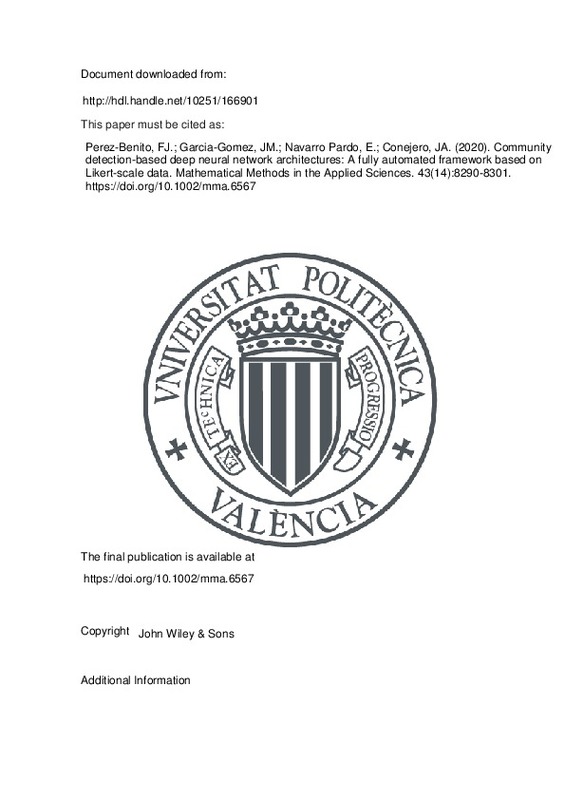LeCun, Y., Bengio, Y., & Hinton, G. (2015). Deep learning. Nature, 521(7553), 436-444. doi:10.1038/nature14539
Antonov, V., Tarkhov, D., & Vasilyev, A. (2018). Unified approach to constructing the neural network models of real objects. Part 1. Mathematical Methods in the Applied Sciences, 41(18), 9244-9251. doi:10.1002/mma.5205
Arifovic, J., & Gençay, R. (2001). Using genetic algorithms to select architecture of a feedforward artificial neural network. Physica A: Statistical Mechanics and its Applications, 289(3-4), 574-594. doi:10.1016/s0378-4371(00)00479-9
[+]
LeCun, Y., Bengio, Y., & Hinton, G. (2015). Deep learning. Nature, 521(7553), 436-444. doi:10.1038/nature14539
Antonov, V., Tarkhov, D., & Vasilyev, A. (2018). Unified approach to constructing the neural network models of real objects. Part 1. Mathematical Methods in the Applied Sciences, 41(18), 9244-9251. doi:10.1002/mma.5205
Arifovic, J., & Gençay, R. (2001). Using genetic algorithms to select architecture of a feedforward artificial neural network. Physica A: Statistical Mechanics and its Applications, 289(3-4), 574-594. doi:10.1016/s0378-4371(00)00479-9
IslamB‐U BaharudinZ RazaM‐Q NallagowndenP.Optimization of neural network architecture using genetic algorithm for load forecasting. In: 5th International Conference on Intelligent and Advanced Systems (ICIAS) 2014;2014:1‐6.
KoutníkJ SchmidhuberJ GomezF.Evolving deep unsupervised convolutional networks for vision‐based reinforcement learning. In: Proceedings of the 2014 annual conference on genetic and evolutionary computation ACM;2014:541‐548.
VidnerováP NerudaR.Evolving keras architectures for sensor data analysis Federated Conference on Computer Science and Information Systems (FedCSIS) 2017IEEE;2017:109‐112.
Albert, R., & Barabási, A.-L. (2002). Statistical mechanics of complex networks. Reviews of Modern Physics, 74(1), 47-97. doi:10.1103/revmodphys.74.47
Newman, M., Barabási, A.-L., & Watts, D. J. (2011). The Structure and Dynamics of Networks. doi:10.1515/9781400841356
Albert, R., Jeong, H., & Barabási, A.-L. (1999). Diameter of the World-Wide Web. Nature, 401(6749), 130-131. doi:10.1038/43601
Redner, S. (1998). How popular is your paper? An empirical study of the citation distribution. The European Physical Journal B, 4(2), 131-134. doi:10.1007/s100510050359
Ito, T., Chiba, T., Ozawa, R., Yoshida, M., Hattori, M., & Sakaki, Y. (2001). A comprehensive two-hybrid analysis to explore the yeast protein interactome. Proceedings of the National Academy of Sciences, 98(8), 4569-4574. doi:10.1073/pnas.061034498
BarabásiA‐L.Network medicine ‐ from obesity to the diseasom:Mass Medical Soc;2007.
Jian, F., & Dandan, S. (2016). Complex Network Theory and Its Application Research on P2P Networks. Applied Mathematics and Nonlinear Sciences, 1(1), 45-52. doi:10.21042/amns.2016.1.00004
FortunatoS CastellanoC.Community structure in graphs. In: Computational complexity;2012:490‐512.
Kernighan, B. W., & Lin, S. (1970). An Efficient Heuristic Procedure for Partitioning Graphs. Bell System Technical Journal, 49(2), 291-307. doi:10.1002/j.1538-7305.1970.tb01770.x
Scott, J. (2017). Social Network Analysis. doi:10.4135/9781529716597
Amaral, L. A. N., Scala, A., Barthelemy, M., & Stanley, H. E. (2000). Classes of small-world networks. Proceedings of the National Academy of Sciences, 97(21), 11149-11152. doi:10.1073/pnas.200327197
Marchiori, M., & Latora, V. (2000). Harmony in the small-world. Physica A: Statistical Mechanics and its Applications, 285(3-4), 539-546. doi:10.1016/s0378-4371(00)00311-3
Luo, W., Lu, N., Ni, L., Zhu, W., & Ding, W. (2020). Local community detection by the nearest nodes with greater centrality. Information Sciences, 517, 377-392. doi:10.1016/j.ins.2020.01.001
YanardagP VishwanathanS‐V‐N.Deep graph kernels. In: Proceedings of the 21th acm sigkdd international conference on knowledge discovery and data mining;2015:1365‐1374.
LiJ ZhangH HanZ RongY ChengH HuangJ.Adversarial attack on community detection by hiding individuals. In: Proceedings of the web conference 2020;2020:917‐927.
Khodayar, M., & Wang, J. (2019). Spatio-Temporal Graph Deep Neural Network for Short-Term Wind Speed Forecasting. IEEE Transactions on Sustainable Energy, 10(2), 670-681. doi:10.1109/tste.2018.2844102
Pérez-Benito, F. J., Villacampa-Fernández, P., Conejero, J. A., García-Gómez, J. M., & Navarro-Pardo, E. (2019). A happiness degree predictor using the conceptual data structure for deep learning architectures. Computer Methods and Programs in Biomedicine, 168, 59-68. doi:10.1016/j.cmpb.2017.11.004
Spector, P. (1992). Summated Rating Scale Construction. doi:10.4135/9781412986038
Cacioppo, J. T., & Berntson, G. G. (1994). Relationship between attitudes and evaluative space: A critical review, with emphasis on the separability of positive and negative substrates. Psychological Bulletin, 115(3), 401-423. doi:10.1037/0033-2909.115.3.401
Newman, M. E. J., & Girvan, M. (2004). Finding and evaluating community structure in networks. Physical Review E, 69(2). doi:10.1103/physreve.69.026113
Clauset, A., Newman, M. E. J., & Moore, C. (2004). Finding community structure in very large networks. Physical Review E, 70(6). doi:10.1103/physreve.70.066111
Blondel, V. D., Guillaume, J.-L., Lambiotte, R., & Lefebvre, E. (2008). Fast unfolding of communities in large networks. Journal of Statistical Mechanics: Theory and Experiment, 2008(10), P10008. doi:10.1088/1742-5468/2008/10/p10008
Arenas, A., Duch, J., Fernández, A., & Gómez, S. (2007). Size reduction of complex networks preserving modularity. New Journal of Physics, 9(6), 176-176. doi:10.1088/1367-2630/9/6/176
Traag, V. A. (2015). Faster unfolding of communities: Speeding up the Louvain algorithm. Physical Review E, 92(3). doi:10.1103/physreve.92.032801
HagbergAric SwartPieter S ChultDaniel.Exploring network structure dynamics and function using networkx Los Alamos National Lab.(LANL) Los Alamos NM (United States);2008.
AbadiM BarhamP ChenJ et al.Tensorflow: a system for large‐scale machine learning. In: 12th USENIX symposium on operating systems design and implementation (OSDI 16);2016:265‐283.
Joseph, S., Linley, P. A., Harwood, J., Lewis, C. A., & McCollam, P. (2004). Rapid assessment of well-being: The Short Depression-Happiness Scale (SDHS). Psychology and Psychotherapy: Theory, Research and Practice, 77(4), 463-478. doi:10.1348/1476083042555406
Carver, C. S. (1997). You want to measure coping but your protocol’ too long: Consider the brief cope. International Journal of Behavioral Medicine, 4(1), 92-100. doi:10.1207/s15327558ijbm0401_6
Francis, L. J., Brown, L. B., & Philipchalk, R. (1992). The development of an abbreviated form of the revised Eysenck personality questionnaire (EPQR-A): Its use among students in England, Canada, the U.S.A. and Australia. Personality and Individual Differences, 13(4), 443-449. doi:10.1016/0191-8869(92)90073-x
Sherbourne, C. D., & Stewart, A. L. (1991). The MOS social support survey. Social Science & Medicine, 32(6), 705-714. doi:10.1016/0277-9536(91)90150-b
LawrenceS GilesC‐L TsoiA‐C.Lessons in neural network training: overfitting may be harder than expected. In: AAAI/IAAI;1997:540‐545.
[-]







![[Cerrado]](/themes/UPV/images/candado.png)


